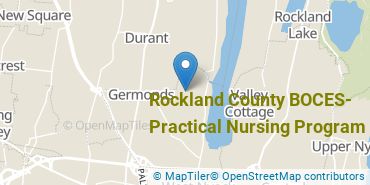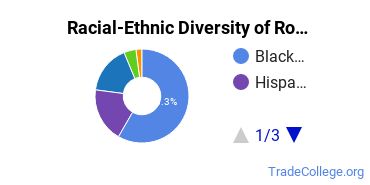Rockland County BOCES-Practical Nursing Program Trade Programs
Rockland County BOCES-Practical Nursing Program is a public institution located in West Nyack, New York. Rockland County BOCES-Practical Nursing Program is located in a safe and convenient suburb.
Featured schools near , edit
Where Is Rockland County BOCES-Practical Nursing Program?

Contact details for Rockland County BOCES-Practical Nursing Program are given below.
| Contact Details | |
|---|---|
| Address: | 65 Parrott Rd, Bldg 3, West Nyack, NY 10994 |
| Phone: | 845-627-4770 |
| Website: | www.rocklandboces.org |
Can I Afford Rockland County BOCES-Practical Nursing Program?
Student Loan Debt
It's not uncommon for college students to take out loans to pay for school. In fact, almost 66% of students nationwide depend at least partially on loans. At Rockland County BOCES-Practical Nursing Program, approximately 78% of students took out student loans averaging $6,276 a year. That adds up to $25,104 over four years for those students.
Rockland County BOCES-Practical Nursing Program Undergraduate Student Diversity
Gender Diversity
Of the 45 full-time undergraduates at Rockland County BOCES-Practical Nursing Program, 22% are male and 78% are female.

Racial-Ethnic Diversity
The racial-ethnic breakdown of Rockland County BOCES-Practical Nursing Program students is as follows.

| Race/Ethnicity | Number of Grads |
|---|---|
| Asian | 3 |
| Black or African American | 23 |
| Hispanic or Latino | 10 |
| White | 7 |
| International Students | 0 |
| Other Races/Ethnicities | 2 |
Rockland County BOCES-Practical Nursing Program Trade School Concentrations
The table below shows the number of awards for each concentration.
| Major | Undergraduate Certificate | TOTAL |
|---|---|---|
| Licensed Practical/Vocational Nurse Training | 29 | 29 |
| TOTAL | 29 | 29 |
References
*The racial-ethnic minorities count is calculated by taking the total number of students and subtracting white students, international students, and students whose race/ethnicity was unknown. This number is then divided by the total number of students at the school to obtain the racial-ethnic minorities percentage.
More about our data sources and methodologies.
Featured Schools
 Request Info
Request Info
|
Southern New Hampshire University You have goals. Southern New Hampshire University can help you get there. Whether you need a bachelor's degree to get into a career or want a master's degree to move up in your current career, SNHU has an online program for you. Find your degree from over 200 online programs. Learn More > |
